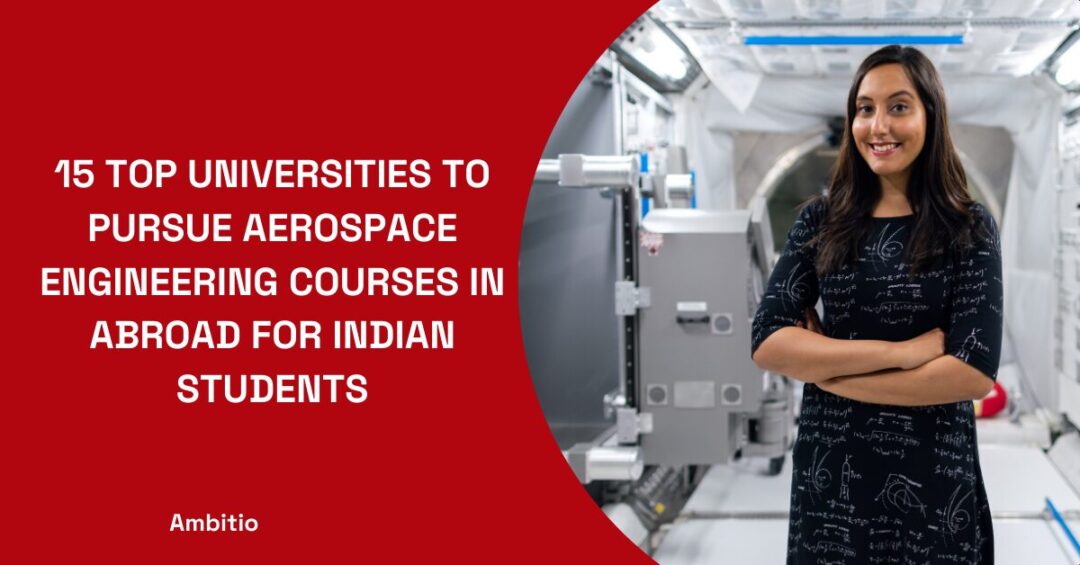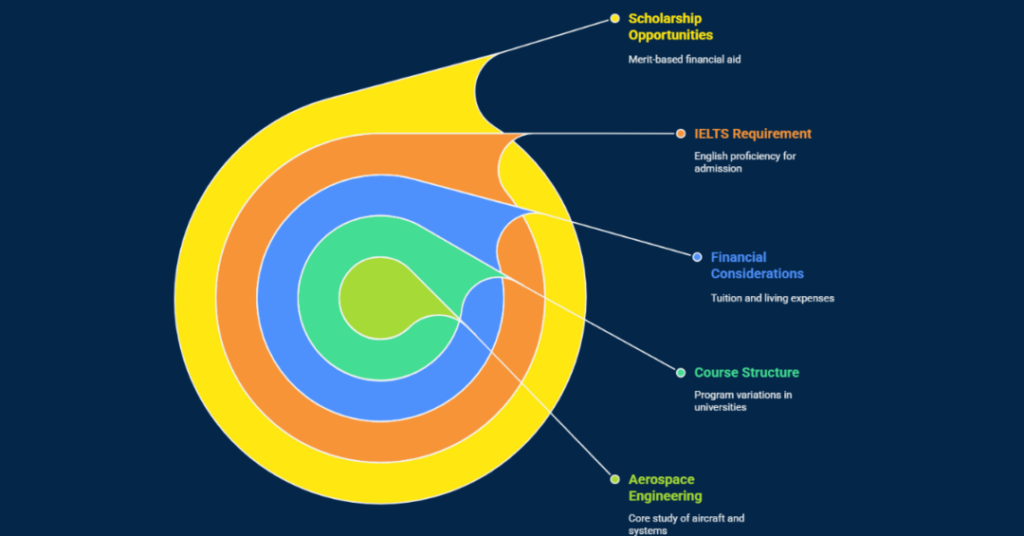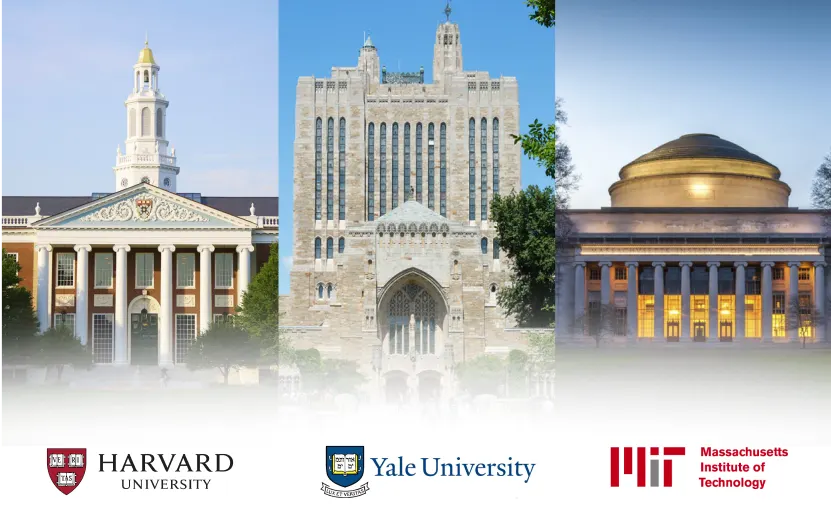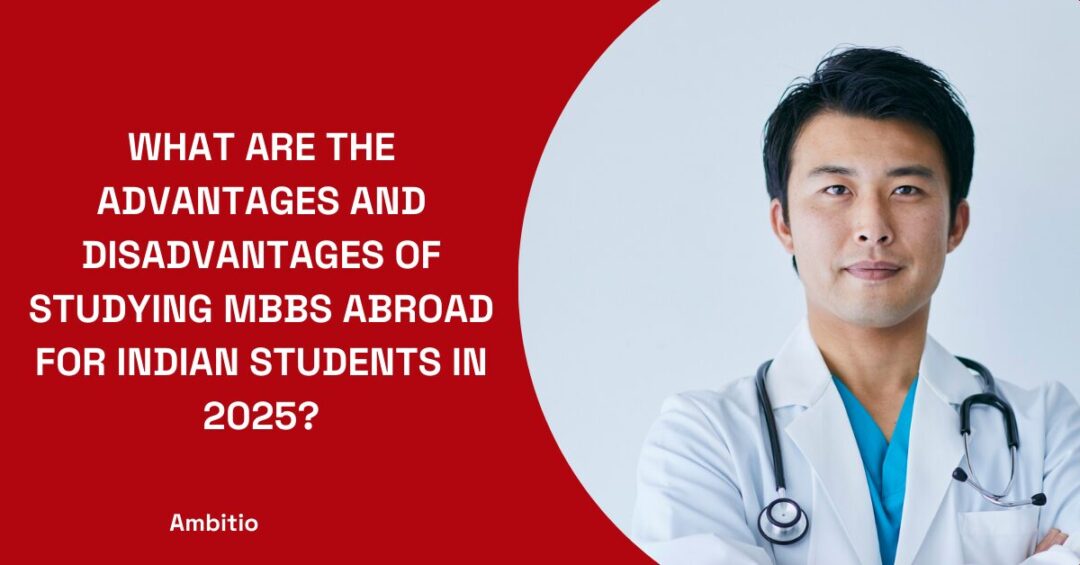8 September 2025
5 minutes read
15 Top Universities To Pursue Aerospace Engineering Courses In Abroad For Indian Students

Key Takeaways
- Aerospace engineering courses abroad demand more than marks with only 1 in 7 applicants making it, so focus on eligibility, IELTS, and complete documents.
- Tuition fees range from ₹18 to ₹40 lakhs annually and hidden costs like accommodation can add ₹8 to ₹12 lakhs.
- Specialising early in propulsion, aerodynamics, or design improves career opportunities and gives graduates an edge in the aerospace industry.
In 2024, only 1 in 7 students who applied for aerospace engineering abroad actually made it to a university programme they aimed for.
Last month, I spoke with a student who had scored 95 in physics and had already built a mini aircraft design model in school. He was confident about getting into an aerospace engineering course abroad, but the university rejected him because his IELTS score missed the cutoff by just 0.5. That’s how precise this journey is. Every requirement, from entrance tests to scholarships, matters, and missing even one can push your dream back a year.
What Is Aerospace Engineering Course All About?
Before I tell you what this course will teach you, let me first explain what aerospace engineering actually is and who should study it. This isn’t just another one of those engineering courses you pick because it sounds fancy. If you’re planning to study abroad, here’s what you need to know.

- An aerospace engineer doesn’t just study aircraft; the course blends aeronautical design with systems engineering, which means you’ll also learn how satellites, rockets, and even drones function.
- Universities in the UK and abroad structure their programme differently: some start with broad undergraduate modules before moving into specialized postgraduate research. Knowing this helps you decide early if you want design-heavy learning or systems-based problem solving.
- Tuition fees can be anywhere between ₹20 to ₹35 lakhs a year depending on the university, but most students forget to add accommodation and daily expenses—together they often cost as much as the academic fee.
- IELTS is more than just a formality; a low score can block you from scholarships and top universities, especially in competitive aeronautical and postgraduate programmes.
- Scholarships are limited, often tied to your grades and research potential, not just financial need. If you’re serious about studying abroad, you’ll need to align your academic profile with the scholarship criteria right from your undergraduate years.
15 Top Aerospace Engineering Universities To Study In Abroad
When I was researching aerospace engineering programs for Indian students a few months back, I realised most universities abroad publish glossy brochures with rankings and facilities but almost no real data on tuition fees, accommodation details to study, or actual career opportunities.
That’s where most applicants go wrong; they fall for the marketing, not the maths. If you’re serious about studying aerospace engineering in abroad, you need to look at the numbers, entry requirements, and whether the aerospace industry around that university can offer you practical experience after graduation.
Here’s a table I often share with international students who want to check fees, compare popular universities, and see where an aerospace engineering degree can actually take them:
| University / College | Country | Average Tuition Fees (per year) | Average Graduate Salary |
|---|---|---|---|
| University of California, Berkeley | USA | ₹32–35 Lakhs | ₹65–70 Lakhs |
| University of Sydney | Australia | ₹28–30 Lakhs | ₹55–60 Lakhs |
| Queen Mary University of London | UK | ₹24–26 Lakhs | ₹48–52 Lakhs |
| University of Sheffield | UK | ₹23–25 Lakhs | ₹46–50 Lakhs |
| University of Hertfordshire | UK | ₹18–20 Lakhs | ₹42–46 Lakhs |
| Delft University of Technology | Netherlands | ₹16–18 Lakhs | ₹45–50 Lakhs |
| ETH Zurich | Switzerland | ₹14–16 Lakhs | ₹55–60 Lakhs |
| McGill University | Canada | ₹22–24 Lakhs | ₹47–52 Lakhs |
| Georgia Institute of Technology | USA | ₹30–32 Lakhs | ₹65–70 Lakhs |
| University of Toronto | Canada | ₹25–28 Lakhs | ₹52–56 Lakhs |
| Politecnico di Milano | Italy | ₹12–15 Lakhs | ₹40–45 Lakhs |
| Cranfield University | UK | ₹22–24 Lakhs | ₹50–55 Lakhs |
| Imperial College London | UK | ₹32–35 Lakhs | ₹70–75 Lakhs |
| Nanyang Technological University | Singapore | ₹20–22 Lakhs | ₹50–55 Lakhs |
| MIT (Massachusetts Institute of Technology) | USA | ₹40–42 Lakhs | ₹80–85 Lakhs |
What Is The Eligibility Criteria To Study MEng Aerospace Engineering In Abroad?
Every year thousands dream of studying aerospace engineering abroad, but only a fraction clear the eligibility stage. Universities abroad want more than marks. They assess discipline, proficiency, and critical thinking to survive an MEng Aerospace Engineering programme.
Acceptance rates at top universities average 15 to 20 percent, while nearly 40 percent of international students, especially Indian students, lose out due to incomplete documents, low IELTS scores, or missing entry requirements.
| Requirement | Details |
|---|---|
| Academic Qualification | A strong undergraduate degree (BEng Aerospace Engineering, Mechanical, or related engineering discipline) with minimum 60–70% for Indian students. |
| English Proficiency (IELTS/TOEFL/PTE) | IELTS 6.5–7.0 (no band less than 6.0) or equivalent TOEFL/PTE score. |
| Entrance Exams (GRE/GMAT, where required) | GRE is optional for most universities abroad, but some US universities (like University of California) prefer it. |
| Statement of Purpose (SOP) | 800–1200 words highlighting why you want to specialise in aerospace engineering, mentioning design engineer aspirations, research interests in computational fluid dynamics or finite element analysis. |
| Letters of Recommendation (LORs) | 2–3 recommendations from professors or industry supervisors. |
| CV/Resume | Detailed academic and professional background. |
| Proof of Funds | Bank statements covering tuition fees + accommodation details to study abroad for at least one year. |
| Passport and Visa Documents | Valid passport, visa application, and health insurance records. |
6 Tips No One Would Tell You To Get Into Top Universities
If you ask me, they don’t care, I mean, the universities, they don’t care if you built a paper aircraft in school or topped mathematics once. They want applicants who know the aerospace industry inside out, who treat an aerospace engineering course like a discipline, and who understand that eligibility is about more than ticking boxes.
If you’re an Indian student planning to study abroad, stop chasing rankings blindly and start focusing on what actually gets you admitted.
1. Stop Worshipping Rankings, Start Understanding Programmes
I have seen students chase universities ranked Top 10 and end up with nothing but theory. The University of Hertfordshire ranks below 500 globally yet offers more hands-on aerodynamics labs than the University of California. Always study the programme modules, not the ranking.
2. Eligibility Is Not Just Marks, It’s Mental Stamina
Around 38 percent of Indian students who apply for MEng Aerospace Engineering abroad get rejected, not for grades, but for weak IELTS scores or incomplete visa files. Marks open the door, but discipline and paperwork get you inside.
3. SOP Is Your Secret Weapon, Not Just Homework
Nine out of ten SOPs I review sound identical. The one percent that stand out talk about real projects—finite element analysis done in the final year, computational fluid dynamics models tested in labs, or design work linked to the aerospace industry. That is what top universities remember.
4. Check Fees and Accommodation Before You Commit
Aerospace engineering degrees cost between ₹18 and ₹40 lakhs annually. Add another ₹8 to ₹12 lakhs for accommodation, lab charges, and insurance. I have seen families budget for tuition only and then drop the plan because hidden costs doubled the bill. Always check fees in detail.
5. Open Days and RAeS Membership Give You an Edge
Less than 5 percent of Indian applicants attend open days. Those who do often secure faster admits because professors already know their face and questions. Membership at RAeS costs less than ₹2,000 a year but adds weight in applications, especially for doctorate pathways.
6. Learn To Specialise Before You Graduate
BEng Aerospace Engineering gives you 3 years. MEng gives you 4. If you don’t specialise in propulsion, aerodynamics, or aerospace vehicle design by the second year, you lose ground. Employers in the aerospace industry shortlist graduates who show depth early, not generalists.
Conclusion
Overall, the students who make it are the ones who prepare documents months in advance, track fee and accommodation details closely, and show depth in their coursework. If you’re aiming for MEng or BEng Aerospace Engineering, plan your pathway early and keep your focus sharp on the skills and specialisations that actually matter in the aerospace industry.
I know, you’ll still have many questions, about the right aerospace engineering course, IELTS cutoffs, tuition fees, or scholarships. That’s where Ambitio helps. We guide Indian students to the right universities abroad and make sure nothing slips through the cracks. Book a free consultant call and start your pathway today.
FAQs
What are the eligibility criteria for Indian students to study aerospace engineering abroad?
Most universities require completion of 10+2 with Physics, Chemistry, and Mathematics, along with language proficiency tests like IELTS or TOEFL and entrance exams such as GRE or SAT.
How much does it cost to study aerospace engineering overseas?
Tuition fees typically range from USD 27,000 to 70,000 per year in the USA, and vary in other countries like Australia, Canada, and Germany.
Which countries are best for aerospace engineering courses?
The USA, UK, Canada, Germany, and Australia are popular for their reputed aerospace engineering programs.
What are the top global universities for aerospace engineering?
MIT, Stanford, Delft University, and leading UK universities are highly ranked for aerospace studies.
Are scholarships available for Indian students pursuing aerospace engineering abroad?
Yes, many universities and private organizations offer scholarships for Indian students based on merit and financial need.
Can Indian students work abroad after completing aerospace engineering?
Many countries allow post-study work visas, and global companies recognize Indian engineering degrees for employment.

You can study at top universities worldwide!
Get expert tips and tricks to get into top universities with a free expert session.
Book Your Free 30-Minute Session Now! Book a call now




























